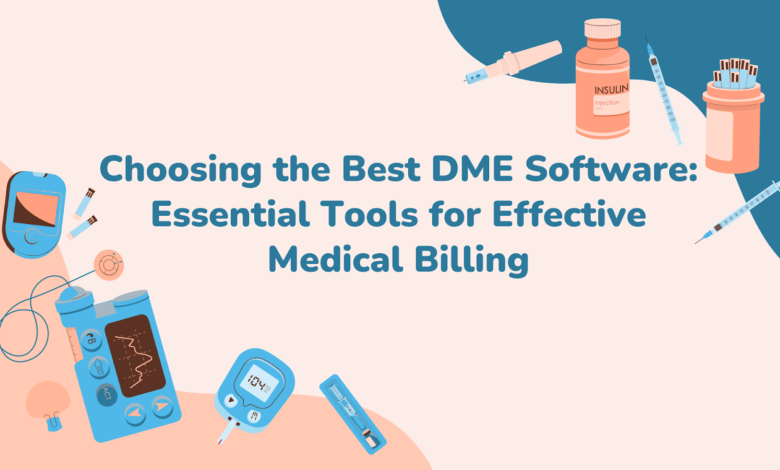Choosing the Best DME Software: Essential Tools for Effective Medical Billing

In today’s healthcare landscape, efficiency and accuracy in medical billing are paramount. This is especially true for Durable Medical Equipment providers, where complex coding and reimbursement rules can lead to significant challenges. Best DME software emerges as a critical solution, streamlining workflows, minimizing errors, and maximizing revenue collection.
The DME Landscape and Billing Challenges
The DME market is projected to reach a staggering USD 480.2 billion by 2025 [source: Grand View Research], highlighting the growing demand for medical equipment like wheelchairs, CPAP machines, and nebulizers. However, this growth comes with its share of complexities. DME billing involves intricate coding requirements from HCPCS and CPT®. Additionally, navigating various insurance regulations and prior authorization processes can be time-consuming and error-prone.
Statistics paint a concerning picture: A 2020 study by the American Academy of Family Physicians (AAFP) revealed that incorrect coding leads to an estimated 10% to 30% of denied claims. This translates to significant revenue loss for DME providers.
The Power of DME Software
DME software empowers providers to overcome these challenges and achieve optimal billing efficiency. Here’s how:
- Automated Coding and Claim Submission: DME software automates the process of assigning accurate HCPCS and CPT® codes based on the equipment provided and services rendered. This minimizes the risk of errors and streamlines claim submission.
- Eligibility and Prior Authorization Management: By connecting directly to insurance databases, the software streamlines patient eligibility checks and automates prior authorization requests, saving time and ensuring approvals happen quickly.
- Real-time Claim Tracking and Reporting: DME software provides real-time tracking of submitted claims, allowing providers to identify and address any issues promptly. Additionally, robust reporting features offer valuable insights into billing performance and areas for improvement.
- Inventory Management: DME software helps track equipment inventory, preventing stockouts and ensuring timely deliveries to patients. This improves operational efficiency and reduces costs.
- Improved Patient Communication: The software facilitates communication with patients regarding equipment delivery, billing statements, and insurance coverage. This fosters better patient engagement and reduces confusion.
Choosing the Best DME Software: Factors to Consider
With a plethora of DME software options available, selecting the right one for your practice requires careful consideration. Here are key factors to evaluate:
- Practice Size and Specialty: Needs differ between a small, single-specialty practice and a large, multi-specialty one. Choose software that caters to your practice’s size and accommodates your specific DME equipment and service offerings.
- Features and Functionality: Identify the functionalities that are most crucial for your workflow. Prioritize features like automated coding, prior authorization assistance, real-time claim tracking, inventory management, and reporting tools.
- Ease of Use: A user-friendly interface is essential for smooth adoption by your staff. Opt for software that is intuitive and offers adequate training and support resources.
- Integration Capabilities: Make sure the software connects smoothly with your current practice management and electronic health record systems. This will prevent you from having to enter the same data twice and will help your workflow run more efficiently.
- Security and Compliance: Choose software that adheres to HIPAA regulations and offers robust security features to protect patient information.
- Scalability: Select software that can scale up to accommodate your evolving needs without requiring a complete system overhaul.
- Cost and Pricing: DME software pricing models vary. Evaluate the features offered against the cost to ensure you receive the best value for your investment. Consider factors like upfront licensing fees, monthly subscription costs, and per-transaction charges.
Benefits Beyond Billing
The advantages of DME software extend beyond streamlined billing. Here are some additional benefits:
- Improved Staff Productivity: By automating repetitive tasks, DME software frees staff to focus on higher-value activities like patient care.
- Enhanced Patient Care: Efficient billing processes allow providers to dedicate more time to patients, resulting in improved overall patient satisfaction.
- Increased Revenue Collection: Reduced errors and faster claim processing contribute to maximized revenue capture for your practice.
Conclusion
In today’s competitive healthcare environment, DME medical billing is an indispensable tool for DME providers. By carefully evaluating your practice’s unique needs and selecting the right software, you can streamline billing processes, minimize errors, and optimize revenue collection. This allows you to focus on what matters most – providing exceptional patient care.



